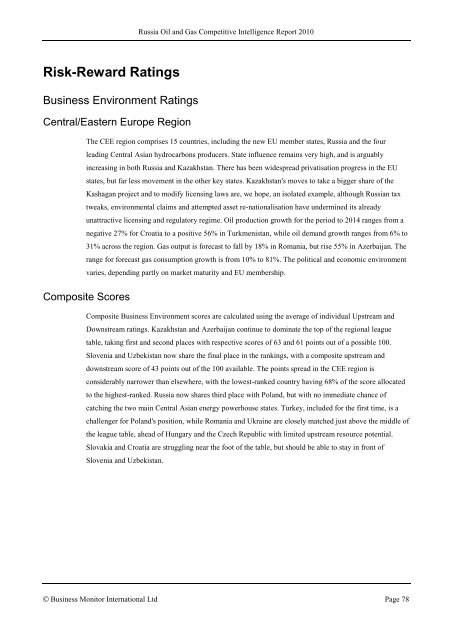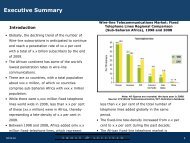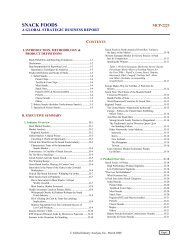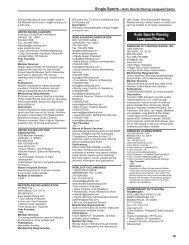the RUSSIA oil & gas competitive intelligence report - Report Buyer
the RUSSIA oil & gas competitive intelligence report - Report Buyer
the RUSSIA oil & gas competitive intelligence report - Report Buyer
You also want an ePaper? Increase the reach of your titles
YUMPU automatically turns print PDFs into web optimized ePapers that Google loves.
Russia Oil and Gas Competitive Intelligence <strong>Report</strong> 2010<br />
Risk-Reward Ratings<br />
Business Environment Ratings<br />
Central/Eastern Europe Region<br />
The CEE region comprises 15 countries, including <strong>the</strong> new EU member states, Russia and <strong>the</strong> four<br />
leading Central Asian hydrocarbons producers. State influence remains very high, and is arguably<br />
increasing in both Russia and Kazakhstan. There has been widespread privatisation progress in <strong>the</strong> EU<br />
states, but far less movement in <strong>the</strong> o<strong>the</strong>r key states. Kazakhstan's moves to take a bigger share of <strong>the</strong><br />
Kashagan project and to modify licensing laws are, we hope, an isolated example, although Russian tax<br />
tweaks, environmental claims and attempted asset re-nationalisation have undermined its already<br />
unattractive licensing and regulatory regime. Oil production growth for <strong>the</strong> period to 2014 ranges from a<br />
negative 27% for Croatia to a positive 56% in Turkmenistan, while <strong>oil</strong> demand growth ranges from 6% to<br />
31% across <strong>the</strong> region. Gas output is forecast to fall by 18% in Romania, but rise 55% in Azerbaijan. The<br />
range for forecast <strong>gas</strong> consumption growth is from 10% to 81%. The political and economic environment<br />
varies, depending partly on market maturity and EU membership.<br />
Composite Scores<br />
Composite Business Environment scores are calculated using <strong>the</strong> average of individual Upstream and<br />
Downstream ratings. Kazakhstan and Azerbaijan continue to dominate <strong>the</strong> top of <strong>the</strong> regional league<br />
table, taking first and second places with respective scores of 63 and 61 points out of a possible 100.<br />
Slovenia and Uzbekistan now share <strong>the</strong> final place in <strong>the</strong> rankings, with a composite upstream and<br />
downstream score of 43 points out of <strong>the</strong> 100 available. The points spread in <strong>the</strong> CEE region is<br />
considerably narrower than elsewhere, with <strong>the</strong> lowest-ranked country having 68% of <strong>the</strong> score allocated<br />
to <strong>the</strong> highest-ranked. Russia now shares third place with Poland, but with no immediate chance of<br />
catching <strong>the</strong> two main Central Asian energy powerhouse states. Turkey, included for <strong>the</strong> first time, is a<br />
challenger for Poland's position, while Romania and Ukraine are closely matched just above <strong>the</strong> middle of<br />
<strong>the</strong> league table, ahead of Hungary and <strong>the</strong> Czech Republic with limited upstream resource potential.<br />
Slovakia and Croatia are struggling near <strong>the</strong> foot of <strong>the</strong> table, but should be able to stay in front of<br />
Slovenia and Uzbekistan.<br />
© Business Monitor International Ltd Page 78









